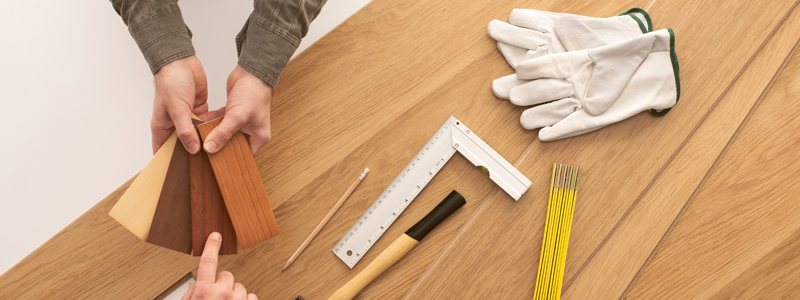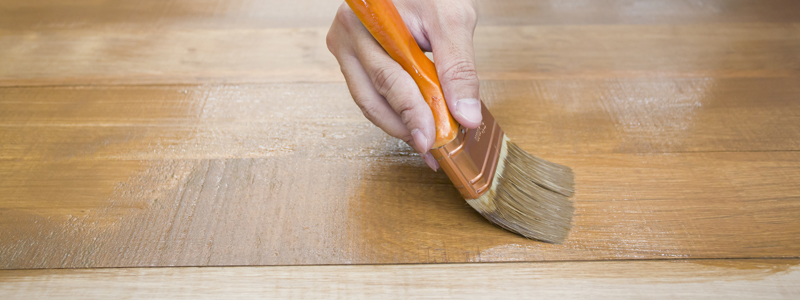Your Guide to Choosing Wood Flooring

Wood flooring is a practical, reliable and affordable choice, designed to perform and age gracefully over a lifetime. It brings a wonderful sense of nature into the home, creates interest beneath the feet and can completely change the look of your interior.
Choosing from our collection might seem complicated. But when you know the ins and outs, making a decision to suit your taste and lifestyle is much easier. This guide covers all the slightly more technical considerations involved in wood flooring, taking away any apprehension and putting the enjoyment back into selecting a stylish new floor for your home.

Solid, Engineered, Bamboo or Laminate Flooring
Solid Wood
Solid wood flooring is traditional and timeless. Each plank is constructed from a single piece of timber and engineered with a tongue and groove joint for straightforward fitting. The result is a durable timber flooring masterpiece which is lovely to look at and will perform for a lifetime.
Our solid wood range is the only range in our collection where packs include variable lengths of board for a defined, authentic look across the floor. Just bear in mind that we don’t recommend pairing solid planks with underfloor heating as they don’t have sufficient stability for the heat fluctuations involved.
Engineered Wood
Engineered wood flooring is the contemporary adaptation of solid wood, built to provide extra stability and reliability in your home. These planks consist of a hardwood veneer which varies from 2.5 to 6mm thick, a central core and a stabilizing backing board – both of which are made up of multiple layers of high density fiberboard (HDF), softwood or plywood. These layers are bonded together at alternative angles to provide excellent support and stability to the floor.
Don’t shy away from engineered flooring just because it has a smaller layer of hardwood than solid wood planks. Remember that just 1mm of wood will last an average of 100 years. That means even our Raglan floors with 2.5mm of hardwood veneer could outlast you and your grandchildren!
Woodpecker engineered planks are constructed in fixed lengths for a more consistent look across the floor that lends itself to both traditional and contemporary settings. Due to their multi-layered construction, engineered floors are also suitable for rooms with underfloor heating.

Bamboo
Bamboo is an amazing material. This unconventional grass is rapidly regenerating making it one of the most sustainable materials known to man. It’s used for everything from bridges to instruments and luxurious bed linen. As a floor covering, we provide it in two varieties of laminated solid strips and strand-woven fibers.
Horizontal Grain Bamboo: Found in our Oxwich range, these planks are bonded in a horizontal direction which shows the rings and stalks of the bamboo randomly throughout the floor. This type of construction provides the closest resemblance to how bamboo appears in nature for a truly exotic look in your home.
Vertical Grain Bamboo: Also found in Oxwich, vertically bonded bamboo is constructed in the same way as horizontal bamboo but these planks are placed vertically for a more uniform appearance. Available in a warm Coffee tone, this floor has been darkened in a process called carbonization which involves smoking the bamboo under extreme heat and pressure.
Strand-woven Bamboo: This type of bamboo is created by mixing and pressing together fibers from the bamboo plant. The result is a much more detailed feel and a floor which is twice as strong as its laminated alternatives. In fact, strand-woven bamboo is the hardest type of floor in our catalogue. It’s available in its natural color, carbonized coffee and two stains for a great choice.
Laminate
Laminate flooring imitates the appearance of real wood. Its color and characteristics are created by a decorative foil which is coated in a layer of protective melamine for durability. This top layer is supported by a high density fiberboard (HDF) core and backed with a stabilizing cellulose paper for optimum strength.
Our laminate floor are suitable for underfloor heating and have an excellent scratch-resistant coating which provides great durability for pets and also allows for easy routine cleaning. Unfortunately, laminate can’t be refinished and repaired in the same way that a hardwood floor can but in the unlikely event of damage, small chips and scratches can be concealed using the Woodpecker Colorfill Repair Kit.

Types of Finishes
Oiled
An oiled finish protects and penetrates the surface of the wood, strengthening and accentuating its grain structure. The result is a muted matte appearance that provides excellent scratch-resistance and allows for isolated areas of damage such as scratches and stains to be easily re-touched without having to re-oil the entire floor. These floors are easier to repair and the best option for pets but bear in mind that they require periodic maintenance earlier into the floor’s lifetime than alternative finishes.
Urethane Finish
A Urethane finish provides a hardwearing surface layer that is shiny and smooth to touch. This coating provides good scratch resistance, is easy to clean and maintain but can be tricky to spot-repair. In the event of a large scratch, it’s likely that the whole floor will need to be sanded and refinished.
Matt Urethane
A matte Urethane floor provides the same hardwearing and scratch resistant benefits of a Urethane floor yet has the appearance of a dull satin sheen which replicates an oiled floor finish. Like a Urethane floor, a matte Urethane coating is easy to clean and maintain but can be tricky to spot-repair.

Types of Species
Oak
Oak is by far the most popular species of hardwood flooring. It’s a durable and extremely hardwearing wood that’s available in a range of colors and is distinguished by its swirling grain patterns. As oak ages, it becomes richer and more luxurious in color while its rustic knots provide the classic detail that has always defined a traditional wood floor.
Walnut
Walnut is a rich dark brown color with distinctive knots and grain patterns. It’s the least hard out of the species in our catalogue yet still a very durable wood which makes a luxurious statement in the home. The advantage of a darker wood is its ability to hide dirt well.
Maple
This creamy white-colored wood has a reddish tinge and fine brown lines. Its grain is relatively subdued and the wood has a uniform texture for an understated result. Maple gives any room a clean and airy feel that’s naturally suited to most interior styles. It’s also a very durable wood that’s harder than oak.
Plank Widths and Lengths
It’s important that you think about the width and length of planks as not just another decision but as a key element to the design of your floor. This detail can dramatically change the finished look and makes a big difference to whether you’re trying to achieve a traditional or contemporary feel.
Standard width planks vary between 130 – 148mm. These create a traditional style of wood flooring and provide a lot of definition across the floor. In comparison, wide plank widths range from 182-190mm. They provide a cleaner and more consistent feel that’s suited to the clean lines of contemporary interiors.
Plank lengths also vary throughout the Woodpecker range. Solid wood is the only type of flooring we offer with variable plank lengths, creating a very defined and authentic feel. The length of our engineered wood planks range from 1860 to 2200mm and the longer the length, then generally more deluxe the result. Yet, beauty is of course in the eye of the beholder!
Beveled and Non-beveled Edges
Beveled
Boards with bevels have been manufactured to include a micro tapered edge. This creates the appearance of slight gaps between the boards which captures the feel of truly traditional timber flooring. Beveled edges are the most common and most popular choice. It might sound odd but beveled edges also have a practical purpose of protecting your floor. Dirt and grime that’s brought onto your floor is likely to fall in between the edges of planks where it’s held until the next time you vacuum. This helps to avoid scratching and damage that may occur from the movement of grit sitting on the surface.
No-bevels / Square Edged
Planks without bevels are cut at 90 degree angles. Achieving this involves a much more difficult process as the results need to be exceptionally precise to create a consistent look across the floor. Non-beveled edges almost give the impression of a floor that is comprised of just a single piece of wood.
Sanding and Refinishing
Our range includes species in their natural colors along with woods that have been smoked, stained and detailed with filler for a more unique look. Wood floors age gracefully and part of their beauty is in their wear and and color changes that may develop over their lifetime.
If you’d like the option of re-sanding and re-finishing your floor to maintain a more pristine look then we’d advise choosing a natural oak, walnut or maple species. These floors can be professionally refreshed with our specialist cleaners, oils and urethane, creating the appearance of a completely new floor every time – a flexibility that’s ideal for floors in high-wear areas.
The amount of times a floor can be re-sanded depends on the thickness of its wear layer, traffic use and wear. Generally, we advise sanding a floor no more than once per 1mm so for example, Harlech Rustic Oak with its 4mm wear layer, could be re-sanded three times over its lifetime with the remaining 1mm still able to provide a lifetime of wear.
This guide covers the most important technical factors to consider when choosing a wood floor yet shouldn’t be taken as an exhaustive look into your options. Choosing a wood floor is about more than the practicality it can provide – it’s about changing a major part of your décor and introducing something that could completely change the look of your room.

